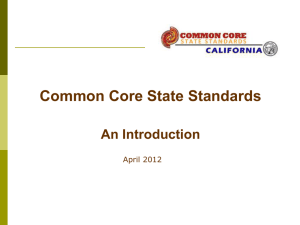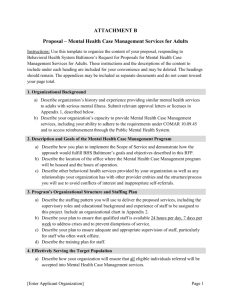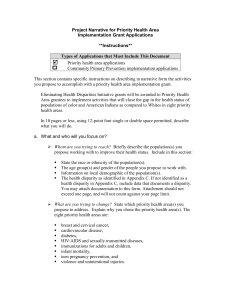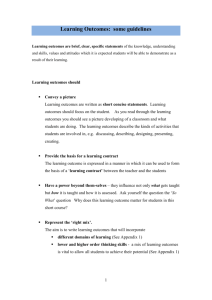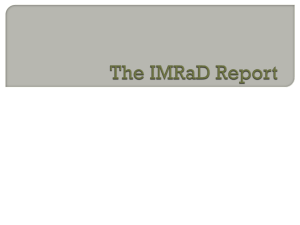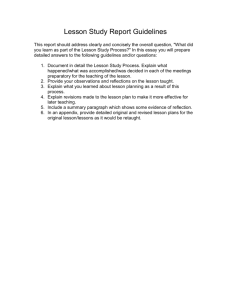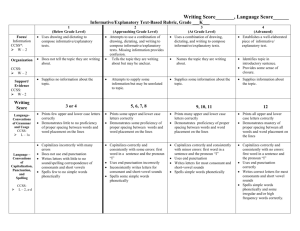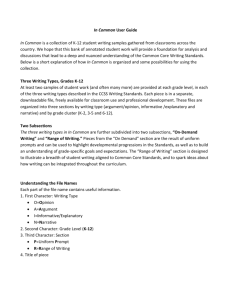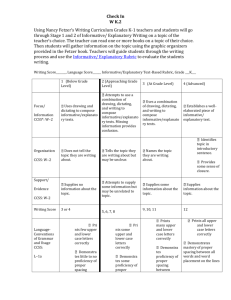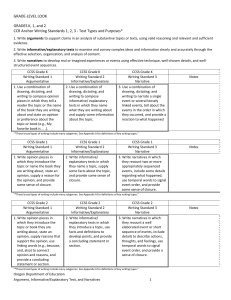The Story of In Common
advertisement
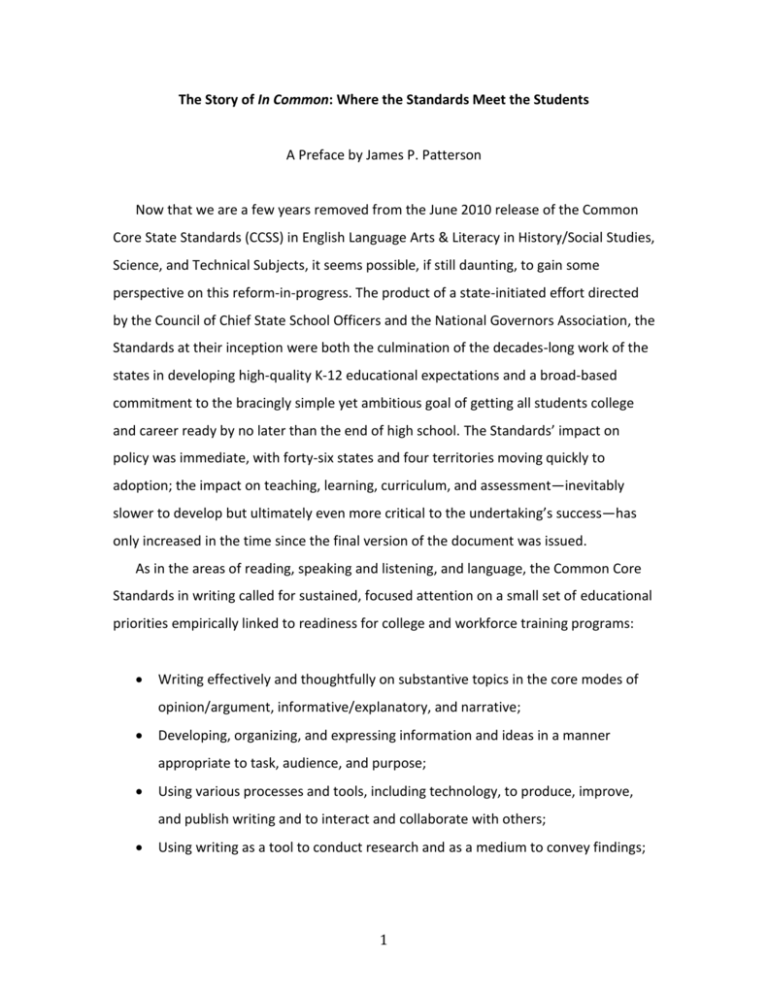
The Story of In Common: Where the Standards Meet the Students A Preface by James P. Patterson Now that we are a few years removed from the June 2010 release of the Common Core State Standards (CCSS) in English Language Arts & Literacy in History/Social Studies, Science, and Technical Subjects, it seems possible, if still daunting, to gain some perspective on this reform-in-progress. The product of a state-initiated effort directed by the Council of Chief State School Officers and the National Governors Association, the Standards at their inception were both the culmination of the decades-long work of the states in developing high-quality K-12 educational expectations and a broad-based commitment to the bracingly simple yet ambitious goal of getting all students college and career ready by no later than the end of high school. The Standards’ impact on policy was immediate, with forty-six states and four territories moving quickly to adoption; the impact on teaching, learning, curriculum, and assessment—inevitably slower to develop but ultimately even more critical to the undertaking’s success—has only increased in the time since the final version of the document was issued. As in the areas of reading, speaking and listening, and language, the Common Core Standards in writing called for sustained, focused attention on a small set of educational priorities empirically linked to readiness for college and workforce training programs: Writing effectively and thoughtfully on substantive topics in the core modes of opinion/argument, informative/explanatory, and narrative; Developing, organizing, and expressing information and ideas in a manner appropriate to task, audience, and purpose; Using various processes and tools, including technology, to produce, improve, and publish writing and to interact and collaborate with others; Using writing as a tool to conduct research and as a medium to convey findings; 1 Making insightful, reciprocal connections between one’s reading and writing, and drawing on an understanding of literary and informational texts to inform and enrich one’s analysis, reflection, and research; and Writing frequently over both extended and shorter time frames for a range of tasks, purposes, and audiences. Published under the unassuming title Samples of Student Writing, Appendix C -the companion document to the Common Core Writing Standards- presented in its roughly one hundred pages nearly three dozen pieces of student work that had been annotated in an effort to clarify and concretize the Writing Standards’ expectations. Through rich and varied examples drawn from students who had written to various tasks, for various purposes and audiences, in various content areas, and under various conditions, Appendix C sought to illustrate by example what it meant to say that a given piece of writing met the Standards. As valuable as that resource has turned out to be, those of us on the ELA/Literacy Standards writing team recognized early in the appendix’s design and development that the document would have some important, if necessary, limitations. First, the included works had not been written expressly to the Common Core Standards. While Appendix C’s samples are easily recognizable as successful—often highly successful—efforts on the part of their student authors, they could only indirectly and by implication suggest what writing informed by the priorities of CCSS would look like. Second, the samples, as diverse as they were, nonetheless came from a relatively small number of sources due to the press of deadlines and the team’s inevitably limited capacity to solicit, evaluate, and annotate materials while simultaneously developing the Standards themselves. Finally, the appendix’s usefulness as a guide to instruction has been hampered to a degree by the fact that, for a variety of reasons (not the least being the already prodigious size of the appendix), only the writing samples and annotations, and not the actual tasks that inspired them, were represented. Enter In Common. 2 Teachers/writers/organizers Joanna Hawkins and Diana Leddy have done the teaching field and the Common Core State Standards Initiative an invaluable service by leading the year-plus-long efforts of two non-profit organizations, the Vermont Writing Collaborative and Student Achievement Partners, and a host of volunteers to collect, compile, and annotate the vast and vital collection of student writing samples available in this resource. Far more than just a supplement to a supplement, In Common advances the work begun in CCSS Appendix C in a number of important ways. The most obvious is in terms of sheer scope: drawn from over 1,600 submissions, In Common comprises more than double the number of annotated samples originally released in 2010. Just as important is the range of the samples, which were gathered from schools across the United States and from teachers united only by their devotion to helping student writers and their interest in infusing practice with the aims and requirements of the Common Core State Standards. Its breadth and depth would be enough to earn In Common high marks, but the resource’s real value lies in its methodology and commentary. Not only have Hawkins, Leddy, and their colleagues pulled together a vibrant array of samples planned, drafted, revised, edited, and published by students working over extended periods of time, but have also conducted and shared with us the results of an intriguing real-world “experiment” in on-demand writing. Beginning with generative questions—for example, “What can you do to save water?” (Kindergarten through Grade 5) and “What effect did the Great Depression have on people who lived through it?” (Grades 6 through 12) for informative/explanatory writing—the project leaders crafted grade-specific argument, informative/explanatory, and narrative writing prompts that were based on source texts and intended to elicit student samples written to nearly uniform tasks across broad grade bands. The result—a stepwise progression of ever-more-sophisticated writing samples with a common baseline—should be required reading for every teacher interested in helping students improve their composition skills. The prompts and source 3 texts have also been included in the collection, allowing readers to analyze how the samples were generated and enabling teachers to replicate the tasks with their own students. Highly trained and skilled educators, Hawkins and Leddy prove sensitive annotators, as well. Their commentary on the eighty-some pieces in this collection strikes a fine balance between making consistent points directly informed by the language of the Writing Standards and recognizing the unique specifics of individual exemplars. These teachers also appreciate the value of letting students’ words speak for themselves. Every piece of writing comes in versions with and without annotations. In addition, some of the samples from the youngest students include a scan of the student’s handproduced original, sometimes with drawings. Understanding, too, that these writing samples may be instructive to students as well as to teachers, the project leaders have included a version of each K-5 sample in which distracting but superficial errors in the conventions of standard written English have been corrected. But enough of these preliminaries. It is one thing to read about how fabulous In Common is; it is another thing entirely to see for oneself. This I charge you to do posthaste. The experience will leave you not only with a better understanding of the Common Core State Standards in writing and how their expectations can be met by students working in authentic contexts in actual classrooms but also, I suspect, with a renewed appreciation and admiration for the heights that students can reach with and through their writing when teachers expect and nurture their best work. -- Jim Patterson, PhD Member, Lead Writing Team, Common Core State Standards in English Language Arts & Literacy in History/Social Studies, Science, and Technical Subjects June 2013 4

